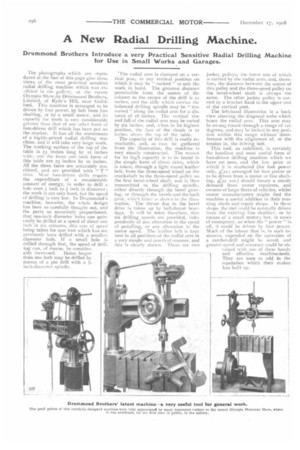A New Radial Drilling Machine.
Page 6

If you've noticed an error in this article please click here to report it so we can fix it.
Drummond Brothers Introduce a very Practical Sensitive Radial for Use in Small Works and Garages. Drilling Machine
The photographs which are reproduced at the foot of this page give three views of the most practical sensitive radial drilling machine which was ex:)ibited in the gallery, at the recent Olympia Show,by Drummond Brothers, Limited, of Ryde's Hill, near Guildford. This machine is arranged to be driven by foot power, by belt from line shafting, or by a small motor, and its capacity for work is very considerably greater than that of any oilier form of foot-driven drill which has been put on the market. It has all the movements of a highly-priced radial drilling machine, and it will take very large work. The working surface of the top of the table is 23 inches long by 12 inches wide, and the front and back faces of this table are 23 inches by to inches. MI the three faces are accurately machined, and are provided with "T " slots. Most foot-driven drills require the expenditure of a considerable amount of energy, in order to drill a hole even inch to inch in diameter ; the work is not only hard, but the speed of drilling is very low. In Drummond's machine, however, the whole design has been so carefully thought out, and the parts so accurately proportioned, that one-inch diameter holes can quite easily be drilled at a speed of about one inch in six minutes, this rate of speed being taken for cast iron which has not previously been drilled with a smallerdiameter hole. If a small hole is drilled through first, the speed of drilling can, of course, be consider
ahlv increased. Holes larger than one inch may be drilled by means of a pin drill with a inch-diameter spindle.
'The radial arm is clamped on a vertical post, to any vertical position on which it may be " racked " to suit the work in hand. The greatest distance permissible from the centre of the column to the centre of the drill is 22 inches, and the slide which carries the balanced drilling spindle may be " traversed " along the radial arm for a distance of 18 inches. The vertical rise and fall of the radial arm may be varied by six inches, and, when in its highest position, the face oft— h e chuck is 12 inches above the lop of the table. The capacity of this drill is really remarkable, and as may be gathered from the illustration, the machine is very stoutly constructed. The reason for its high capacity is to be found in the simple form of direct drive, which is taken, through a light round leather belt, from the three-speed wheel on the crankshaft to the three-speed pulley on the first bevel-wheel shaft, and is then transmitted to the drilling spindle, either directly through the bevel gearing, or through the bevels and the back gear, which latter IS shown in the illustration. The thrust due to the bevel drive is taken up by ball-thrust bearings. It will be seen; therefore, that six drilling speeds are provided, independently of any alteration in the speed of pedalling, or any alteration in the motor speed. The leather belt is kept taut in all positions of the radial arm in a very simple and practical manner, and this is clearly shown. There are two
jockey pulleys, the lower one of which is carried by the radial arm; and, therefore, the distance between the centre of this pulley and the three-speed pulley on the bevel-wheel shaft is always the same. The other jockey pulley is carried by a bracket fixed to the upper end of the vertical post.
The left-hand illustration is a back view showing the diagonal webs which brace the radial arm. This arm may be swung round through a range of 120 degrees, and may be locked in any position within this range without interference with the alignment of, or the tension in, the driving belt. This tool, as exhibited, is certainly the handiest and most useful form of foot-driven drilling machine which we have vet seen, and the low price at which' it is marketed (for foot power only, £22; arranged for foot power or to be driven from a motor or line shafting, £22 ios.) should insure a steady demand from motor repairers, and owners of large fleets of vehicles, whilst motor manufacturers might find the machine a useful addition to their running sheds and repair shops. In these. shops, the tool could be normally driven from the existing line shaftinre or by means of a small motor; but, in cases of emergency, as when the " power " is off, it could be driven by foot power. Much of the labour that is, in such instances, expended on the operation of a ratchet-drill might be saved, and greater speed and accuracy could be obtained with one of these handy and effective machine-tools. They are sure to add to the reputation which their maker has built up.






















